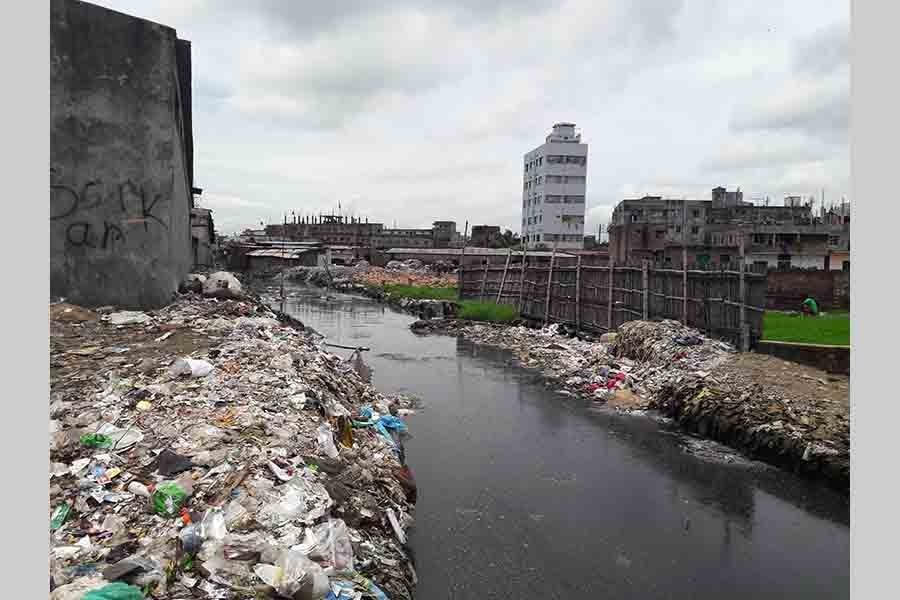The entire efforts of relocating the over 50 years old Hazaribagh Tannery to Savar's Hemayetpur on the outskirts of Dhaka appear futile. Given the nonstop pollution of the Buriganga, and that of the relatively clean Dhaleshwari in Savar, the whole exercise of taking the tannery to the distant Savar could be termed one of the largest engagements in inanity in Bangladesh. It's because futile exercises like it have occurred in the country several times before. The grand and long-term goal on which the old tannery was hauled to a new one outside Dhaka still remains unmet. The already polluted Buriganga river water is still being contaminated by the waste coming from the dozens of small rawhide processing units still unlawfully in operation in Hazaribagh. At the same time, the tannery estate in Hemayetpur on the bank of the Dhaleshwari river keeps releasing solid waste and effluents. The river's water mixed with these pollutants flows downstream into the Buriganga. Thus the river, called the lifeline of Dhaka, still continues to get polluted by it. With an environment-friendly well-equipped tannery estate remaining elusive, the prospects for growth of the tannery industry itself are in jeopardy.
The country expects big from finished leather products' export. Given the rising output of rawhide, the country can be considered a rich source of leather. After the relocation of the half century-old, malfunctioning Hazaribagh complex to a supposedly state-of-the-art tannery estate, high optimism had been seen. Unfortunately, it began evaporating as days wore on. In the interregnum, since the nearly complete relocation of the tannery complex in 2017, few production facilities could be seen in place. A foolproof Central Effluent Treatment Plant (CETP), the centre-piece of the whole saga of the relocation, still remains a pipedream. Months into the opening of the estate, the special plant was put to use. But it proved unsuitable for the tanners. The consequences were obvious. The goal of the operation of a highly ambitious cluster of tanneries proved elusive.
A total of four years after the formal opening of it, the Savar Tannery Estate is still a non-starter to a lot of old and seasoned tanners. There is a highly dampening aspect of the sloppy style of the estate's operation. It is the flow of polluted, waste-filled water into the Dhaleshwari and the adjacent canals and marshes. Had there been a CETP, the tanners' waste could be made to flow into a single water body --- be it a river or a canal. Nothing of the sort materialised. It resulted in the flow in one way or another going into the Buriganga. At this point many can raise the pertinent question of the very rationale of the tannery relocation.
Alongside it, majority of the tanners' opposition to the relocation, the government's warnings, setting of deadlines for shifting, warnings of cancellation of licenses for defiance and lots of other irritants have beset the process. However, after the warning of forced eviction, the relocation process began in earnest.
At this point, many put forward the question --- after all these turbulent phases, what did the tannery owners get? The answer is ready with the pessimists. Most of them will say, 'Nothing worth mentioning.' In reality few can say to what length this style of operation will help the tannery estate function properly. The Covid-19 pandemic and the veritably global shutdown or lockdown has brought about a respite of sorts for the tannery and leather goods production sector. Production and marketing of all commodities and services has veritably ground to a halt. The raw hide preservation, tanning and leather goods manufacture are no exception. But Bangladesh ought to brace for a tough test with the start of the pandemic's recession. In the post-Covid-19 world, the equation in the global business will be plain and forthright. Either get down to brass tacks immediately or make room for others. Given this harsh reality brewing side by side with the appearance of newer corona variants, Bangladesh has few scopes for adopting a laidback attitude. Demand for processed leather and leather products from prospective LDCs and developing countries continued to soar before the pandemic. The trend is set to stage a comeback. In the coming race, Bangladesh shouldn't miss the bus.
Many projects like those in the tannery sector which are already slated to be doomed in the near future are being launched. This is an ominous sign. Besides, these projects are sheer waste of the taxpayers' money. It's time the messed-up tannery sector in Bangladesh was put on a steady course.
At the time of the paperwork on the Hazaribagh tannery complex's shifting to Savar, both the authorities and the affected people in the old tannery area were bubbling with hope. After the complete removal of the polluting tanning factories in 2017, people in a large area heaved a sigh of relief. In a short time, the air was free of the revolting stench of the rotting hides and skin; and the nearby river water turned usable. The veritably uninhabitable swathe regained its earlier healthful vibrancy. People welcomed the authorities for freeing them of a highly polluted atmosphere.
A striking feature distinguishes the area. After Hazaribagh complex's relocation to the Savar Tannery Estate, people in the former venue found an atmosphere conducive to a water and air pollution-free environment. Due to its location near the bank of the long polluted Buriganga, the whole atmosphere including localities, once found itself in a state when it could no longer take in the pollution anymore. Now they are free to breathe, and no longer feel choked.


